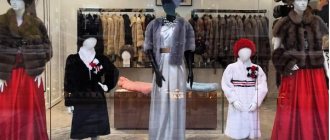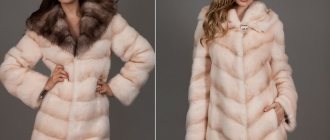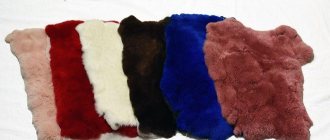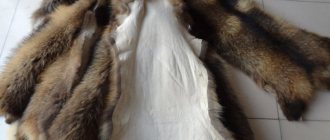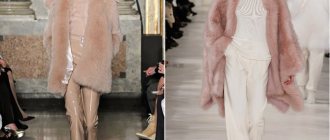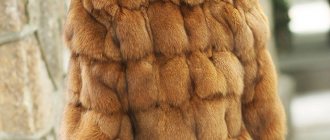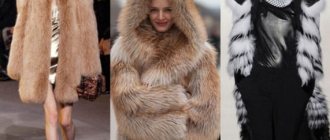The popularity of mink coats is steadily growing every year - beautiful, wearable, warm fur is winning fans of comfort and beauty around the world. Before purchasing such an expensive item, you should consider that the cost of the product will largely depend on the color of the mink. There is an opinion that natural, especially rare, shades are often more expensive than dyed fur. It is not always so. But the quality of fur probably largely depends on its naturalness. And the pricing policy for different natural shades is also different. A natural question arises: what are the natural colors of mink, and how to distinguish them from dyed ones?
Beautiful mink coat
There is a special catalog that lists all the natural shades of mink, of which today there are more than 30. However, there are several main groups that we suggest you understand.
Light mink coat
Natural and artificial mink: differences and similarities
Currently, the mink coat industry offers consumers products made from two types of fur: natural and artificial. The latter option is also called eco-fur.
The differences between them can be considered as follows:
- Price. The cost of an artificial fur coat differs from a natural one, which makes it available for purchase to a wider range of consumers. Speaking in numbers, the price of an eco-fur product is ten to twenty thousand rubles, and a natural product will cost up to one hundred thousand rubles. Cost depends on length, design and manufacturer.
- Life of animals. No animals are harmed in the production of faux fur.
- Storage conditions. Natural fur is susceptible to being eaten by a voracious butterfly, so you need to take care of moth repellent tablets during the off-season. In turn, faux fur is short-lived and tends to fall off - its service life is approximately four years.
- Manufacturing principle. The natural raw material for making a mink coat is the skin of an animal - mink. Faux fur is produced by gluing synthetic fibers (made from polyacrylonitrile, polyester, polyester) onto a different base - cotton or knitted.
- Warming properties. Artificial fur coats have less ability to retain heat than natural ones.
- Due to the specific origin, natural fur, unlike artificial fur, can cause allergies.
- Tactile sensations. Unlike its opponent, faux fur feels rougher and tougher to the touch.
- Color. Eco-fur can be painted in different colors, which allows fashionistas to have several options for fur products - both plain and colored fur coats.
- The only similarity between these products is weight - they are light.
Silver gray mink
Luxurious silver-gray fur coats are one of the most beloved by Russian women (photo). This group also has several primary colors:
- Silver blue is the most common shade of the group, gray with a slight brown tint.
- “Blue Iris” is a dark gray mink with light fur.
- Sapphire is a light gray shade with a slight bluish tint.
- Violet is a light gray, almost white mink with a slight silver tint.
Types of mink and fashionable styles 2017-2018
Why does mink fur vary? Because its quality depends on the place where this animal lives. Depending on this, the types of fur are divided into the following:
- North American mink fur is exquisite, but does not withstand Russian winters due to its short velvet pile;
- Russian mink fur is the warmest of all types, shaggy and shiny;
- Chinese mink fur – not of very good quality, but cheap;
- Scandinavian mink fur is expensive and noble, thick and warm due to the down.
In the arsenal of designers there are almost all types of mink. Since recently, thanks to faux fur, mink coats are no longer a rarity, the couturier has to work hard to create something noticeable, including colored fur coats, photos of which are presented in the article.
The main trends in mink fashion are:
- Good old classic. Long straight-cut models with a belt, with a highlighted shoulder line and a small collar or hood will always be in trend.
- The fashionable colors of the current and next year are considered to be delicate pastel, blue and cream shades, as well as brown. Black and bright blue are no longer in fashion. Colored fur coats have been popular among consumers for many years.
- The ultra-fashionable details of modern mink coats are considered to be a wide leather belt, extended sleeves and length above the knees.
- Youth models are distinguished by a special finishing - the fur is trimmed to a velvety state and plasticity, to create new images.
- The trend in modern fashion is a wide hood and an expanding hem of the skirt type.
- In straight silhouettes, it is fashionable to use wide cuffs.
Thanks to designers today, it is not at all difficult to create a fashionable, unique look.
Brown group
The main and largest group consists of shades of walnut color - scanbrown. This is the natural color of natural mink, which did not require selection. Several shades of scanbrown fur vary from light golden to dark brown chocolate - scanglow, scanbrown, mahogany, demi buff, marble. Brown mink is considered the cheapest, but with proper tailoring and high quality skins, it is no less beautiful than its noble “relatives” of other shades.
Faux mink coat colors
Modern fashion trends do not consider fur coats as products of only natural colors; models have already been invented using a variety of dyeing techniques.
The fashion for changing the color of fur was first discovered in the eighties of the last century by designer Yves Saint Laurent. And in 2021, the fashion house of Miuccia Prada surprised the world with shocking colorful fur - paintings were applied to the fur coats. Faux fur lends itself well to dyeing, and couturiers use this quality.
Moreover, it is noted that a single-color product obliges you to “look at your best” and wear heels, while colored artificial fur coats do not require careful selection of shoes and a special appearance.
Dyeing technology involves first lightening the fur, and then tinting or dyeing.
In recent years, plain mink coats in bright colors have been especially popular among young people: blue, pink, crimson, red and even green.
Modern fashion dictates different conditions - fur coats are made using colored pieces, this is reminiscent of the folk patchwork style, or with a variety of prints depicting fruits, geometric shapes, abstraction, and vegetation. Colored mink coats look unusual, bright, and they stand out stylishly from others.
Types of dyeing of mink coats
As a rule, the most common color that mink skins are dyed is black . If you paint the product correctly, following all the rules and features, then this will not affect the quality in any way. The only thing is that this will affect the price; it will be significantly lower. If this point is not important, then this is the very option that will save money.
Manufacturers who make fur coats are constantly coming up with developments and designs for dyeing mink skins. Experimenting with a variety of colors, dyeing skins in different colors . On the one hand, this is very good, it allows you not to be limited to one color, but on the other, it can mislead the buyer, since there are sellers who can pass off mink as another product.
Types of popular stains:
- The most common methods used to change the color of mink fur products are conventional dipping and tinting . Tinting is used to more or less even out the color of the down and enhance the natural color of the mink. This also helps slow down the appearance of yellow discoloration.
- Tinting with black is necessary when lightening the fur is required.
- Black dyeing - when they try to darken the awn on brown-colored fur to a rich black.
- Strong blue tint - used to enhance the natural color of mink on skins of bluish shades.
- Frost effect is used for painting in two tones.
- Stenciling is when it is necessary to achieve a non-uniform shade, while the design is applied using stencils.
Thanks to the wide variety of types of staining, you can do various experiments.
Pros and cons of dyed fur
When purchasing a natural or colored artificial mink coat, it is important to decide on the purpose of the purchase. Will it be a model for long-term wear or the reason for the purchase is to follow a fashion trend.
Experts do not recommend purchasing colored mink if a woman expects to wear it for “years.” A good fur item in natural colors can last up to 10 seasons. And the wear life of a painted analogue is reduced to 5-7 years.
With constantly changing fashion trends, you also shouldn’t spend money on colored fur products, because they will have to be changed almost every season.
The positive side is the cost. Dyed products are usually cheaper because the fur used for dyeing is light brown (walnut) in color. It is the most accessible.
Powdery
A powder-colored mink coat is a light-colored fur product with a pinkish-beige tint. It belongs to warm shades. In addition, it is considered less prone to yellowing. In general, this is an invention of managers. After all, it comes in all different shades. Moreover, if you want to get a good thing, choose the tone closest to it and imagine what shade of natural mink it is most similar to.
The names of fur shades vary and often depend directly on the taste of the seller, which is what you should pay attention to.
How to distinguish high-quality fur dyeing
Dyeing mink fur almost does not detract from its quality. Therefore, fashionistas equally prefer fur coats in both colored and natural tones. But it is worth carefully inspecting the painted product, because only factory painting guarantees a high-quality result.
Before purchasing a colored mink coat, you must:
- Rub the fur with a clean white cloth. There should be no colored marks left. This means that the paint is durable.
- Spray the fur with water. If the coloring is of poor quality, the hairs will stick together. Well-processed fur does not stick together.
- With aggressive, poor-quality dyeing, fur hairs deteriorate and fall off. You need to tug them or shake the product to check the quality of the coloring.
The fur of a colored mink coat should shine thanks to natural fatty lubrication. Natural or gentle artificial dyes are used for coloring.
In terms of cost, colored mink is usually cheaper than natural tones.
Black
A black mink coat can be dyed, natural or tinted. The natural group of shades belongs to the Scandinavian or American mink (black nafa, blackglama, scanblack). The second most expensive of them.
Black mink is practically a brand. Like every brand, it is too actively counterfeited. Good quality black fur will never be tinted or dyed. Because this makes no economic sense. If you want to get a natural black fur coat, choose carefully.
What to wear with a colored fur coat
Colored mink not only pleases the eye with its brightness and unusualness, but also has an advantage when choosing a wardrobe. Painted models go well with any accessories: gloves, handbag or boots. A colored faux fur coat is almost as beautiful as its natural counterpart.
A mink coat has always been considered a sign of luxury and special status in society. Therefore, accessories must be selected to match the fur product.
Models whose length is above the knee provide an opportunity to show off other clothes and draw attention to boots. Famous couturiers suggest wearing over the knee boots and a wide belt to maintain the look. A miniskirt or dress is also suitable under a short fur coat. In this case, the color schemes must be combined.
Mink coats without a hood are usually equipped with a collar that will keep you warm and protect you from strong winds. It is important to choose the right hat for them. The ideal solution is a hat made of the same fur. But felt models, classic brimmed hats or a fur beret are allowed.
Mink coats of short models look equally beautiful with boots of different lengths and heel heights.
Trouser sets and jeans tucked into shoes go well with any style of fur product.
Sable
Sable mink coats are very popular. They resemble natural sable fur in shade, and many sellers constantly use this: “This is not an ordinary mink, it is a unique, very expensive shade!” As if this turns her into a sable model.
Basically, a sable mink coat refers to brownish-gray fur, often with an underfur of slightly lighter shades. It looks elegant and beautiful. The cross pattern is especially successful in this color - in this case it reveals itself simply extraordinary.
Rules for caring for colored mink coats
For owners of mink coats, natural or artificial, it is important to know several aspects of fur care. If followed, the clothing will last as long as possible and will retain its color and shape.
Tips on how to preserve a colored mink coat:
- Fur does not tolerate moisture. If it so happens that the weather conditions took you by surprise, you don’t have an umbrella at hand and your fur coat gets wet, then upon returning home it needs to be dried thoroughly. But it is not recommended to use a hairdryer or battery - the fur will lose its beauty. You need to shake the fur coat well and hang it on hangers, making sure it is completely dry.
- To avoid stains, you should always wear a scarf or neckerchief. To preserve the color, the fur should not come into contact with cosmetics, perfume or sweat. If an oil stain is found on a fur coat, it is recommended to cover the area with sawdust for 1 hour, then remove it with a vacuum cleaner or brush.
- Inspection. After the end of the cold season, it is important to inspect your fur coat for stains. If any are present, then the fur product should be dry cleaned.
- Ideal storage. Experts advise handing over natural and colored mink fur coats to special storage areas where the temperature regime is maintained and the required humidity is maintained. But this method is not available to every woman. Therefore, there are several rules for preserving fur coats at home:
- the fur coat must be hung on wide and soft hangers, this will prevent deformation and sagging;
- the fur coat should not touch other products; the maximum free space for storage should be allocated;
- a natural cover will ensure maximum safety, because mink fur must “breathe”;
- the product should be stored in a closed, dark place;
- It is recommended to periodically ventilate in the fresh air, but not in direct sunlight, as well as combing with a special brush;
- It is worth taking care of anti-moth substances, but you need to make sure that they do not come into contact with the fur.
A mink coat is a luxurious classic. It requires careful care and respect. Only in this case will the fur coat please the owner with its beauty and sophistication.
Colors
Just a few decades ago, mink was used only in classic styles and was presented exclusively in standard dark shades. But now, with the possibility of selection and breeding in captivity, the types of mink and the color range have expanded much. So, today there are more than fifteen shades of this fur .
It is important to note that the fur cannot be artificially dyed; all colors and shades are the result of crossing and breeding of minks by breeders. Mink in any design and color is an elegant classic, charm and chic.
Light shades of fur: Various tones of white, cream or ivory are considered the rarest and most elite.
The color “Violet” (a silvery-blue shade with a slight grayish tint) is a rarely seen color even at popular world auctions and shows.
The Violet fur is so extraordinarily unique that it may be only one percent of all the furs presented at auctions. Of course, the price for such luxury is appropriate.
It is worth noting that not only rare and expensive furs are not dyed artificially. All unusual and beautiful shades of light color are all natural derived fur colors . Nowadays, the chemical bleaching method is very rarely used to achieve a particular shade, although it is gentle and does not affect the quality of the product in any way.
New modern technologies make it possible to produce the most incredible shades - from ivory, champagne, caramel to golden walnut.
Palomino
Very beautiful, natural color with a range of tones from dark beige to light beige, with a slight undertone of beige or bluish color. It looks great and is quite wearable at the same time. This color is natural. It is sometimes called champagne mink, but the correct name is palomino. There is a light variety of this color - soft cream.
Pastel
Delicate and practical pastel-colored mink coats are one of the most popular options among women of all ages: such models suit everyone and look very beautiful. In general, beige shades have always been very popular. In addition, they are durable in comparison with fur of cold tones - they also turn yellow, although this is not so noticeable and does not catch the eye.
In general, pastel color is often classified as a brown collection, as the tone varies from pale beige to light brown. Although the peculiarity of such a mink is the color of its down, which has a lilac or bluish tint. The latter option is more valuable, since it is a selection type bred in Canada.
